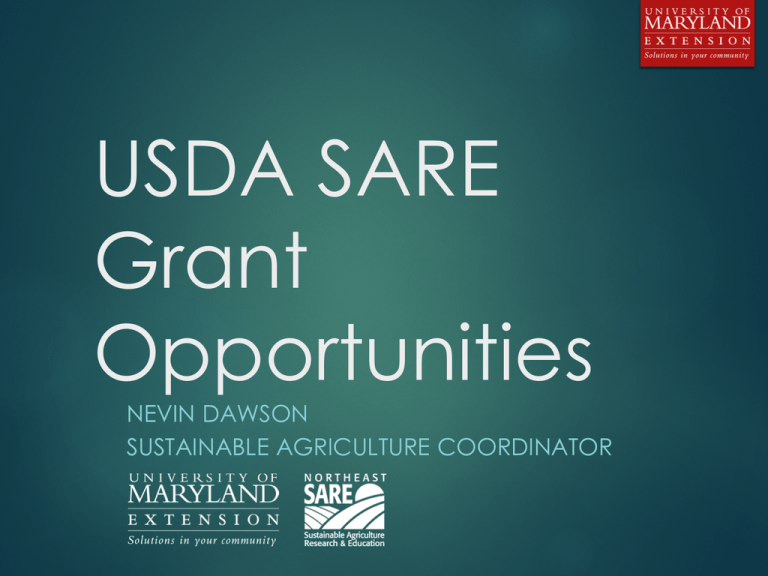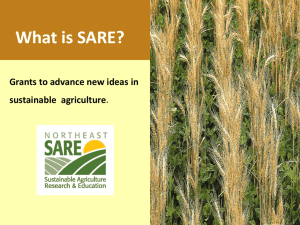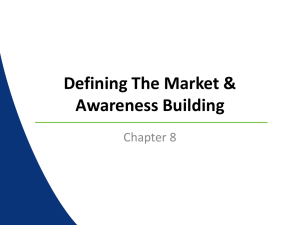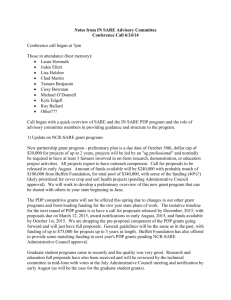SARE Grants Overview
advertisement

USDA SARE Grant Opportunities NEVIN DAWSON SUSTAINABLE AGRICULTURE COORDINATOR My Funding Northeast SARE Professional Development UME Ag Profitability & Sustainability Impact Team …and a couple others What is Sustainable Ag? Congress has defined sustainable agriculture as an integrated system of plant and animal production practices having a site-specific application that will over the long-term: satisfy human food and fiber needs; enhance environmental quality and the natural resource base upon which the agriculture economy depends; make the most efficient use of nonrenewable resources and on-farm resources and integrate, where appropriate, natural biological cycles and controls; sustain the economic viability of farm operations; and enhance the quality of life for farmers and society as a whole. (U.S. Code Title 7, Section 3103) My job Provide professional development for ag service providers (ASPs) Help with grants and grant writing To help ASPs: Implement education programs about sustainable agriculture based on adult learning concepts Document outcomes from their education programs Increase their success in obtaining external program funding Audience (ASPs) Ag Profitability & Sustainability Impact Team MACAA Sea Grant Extension Ag Marketing Professionals NRCS & Soil Conservation Districts Private consultants (e.g. Certified Crop Advisors) MD Ag nutrient management MARBIDCO FSA River Conservancies (ag liaisons) CASA/Future Harvest FFA/High School/4-H MD Ag Resource Council College of Ag faculty Farm credit MD Dept of Ag Farm Bureau MD Dept of Environment Producers Needs Assessment Small Group Discussions Formal Survey Polls Will lead to… 3 year plan to NE SARE 1-3 primary topics Advisory committee Top Ranked Topics Integrated Organic Pest Management Production Alternative/Renewable Energy And Farm the winner: Soil Health Soil Health Soil Health Results are often realized immediately, and last well into the future. Using these four basic principles is the key to improving the health of your soil. Keep the soil covered as much as possible Disturb the soil as little as possible Keep plants growing throughout the year to feed the soil Diversify as much as possible using crop rotation and cover crops Soil Health Conservation Cover No Crop Rotation Crop Till Mulch Tillage Mulching Nutrient Pest Management Management Soil Health Increased organic matter More soil organisms Reduced soil compaction Improved nutrient storage and cycling Absorption and retention of more water Less susceptible to runoff and erosion Less fuel and energy Higher crop yields Buffer for precipitation extremes (too wet or too dry) What is SARE? Grants to advance new ideas in sustainable agriculture What SARE looks for Projects that improve farm profits, stewardship, and the wider farm community. A whole-farm approach. Farmers included as research partners and important reservoirs of knowledge. Two tiers of funding Big grants Outcome-driven, multiyear projects with budgets of $30,000 to $200,000. Little grants One- or two-year projects with budgets of $15,000 or less. . Big grants Research and Education Outcome-driven projects that explore new sustainable techniques and support farmer adoption. Professional Development Outcome-driven projects that deliver sustainable agriculture training to extension, NRCS staff, and other farm professionals. Outcomes Research and Education Grants Measurable and verifiable benefit to farmers. Professional Development Grants Measurable and verifiable benefit to farm educators. Outcomes, also called performance targets, drive biggrant proposals. Outcome statement Agriculture in the Northeast will be diversified and profitable, providing healthful products to its customers. It will be conducted by farmers who manage resources wisely, who are satisfied with their lifestyles, and have a positive influence on their communities and the environment. Research and Education Research and Education awards cover a wide array of topics in production, marketing, and quality of life. Farmers should participate in project development. Projects must improve farm profits, enhance stewardship, or enhance farmer quality of life. Research Research should have an integrated education component. You can- Do research on farm and on station. Hold workshops about the topic. Hold field days at research sites. Publish research results as a farmer-ready fact sheet as well as a journal article. Education Offer robust education that supports farmer engagement to bring active, positive change in farm practices and farmer actions. Verify changes through strong farmer interactions and follow-up. Develop farmer-friendly outreach and teaching tools that will be useful to a wider audience. Outcomes vs. activities Activity: 50 vegetable farmers attend a no-till demonstration. Outcome: 11 farmers report piloting reduced- or no-till practices on 407 acres of land, realizing $76 per acre in input savings. Milestones lead to targets Milestones 282 farmers sign up for tillage workshop 109 attend workshop and learn about reduced and no-till practices; 83 farmers at workshop sign up for farm tour 79 farmers attend farm tour to learn from practicing no/reduced till farmers 50 farmers from tour respond to followup survey about reduced tillage practices Target 11 farmers report adopting reduced- or no-till practices on 407 acres of land, realizing $76 in per acre in input savings. Dilip Venugopal PH D How was the application process? NIFA and FWS SARE was easier as far as submission than above, but amount of money is not much for amount of work Faculty members have presented results at stakeholder and farmer meetings (not him personally); he personally presented at 5-6 extension events Did you have any prior connection with SARE when you first applied for a grant? Galen Dively, through SARE grants—influence was more on shaping the idea he was going to propose than actual Bill Lamp is other co-advisor (one on paper) Was the amount of money limiting? yes What advice would you give someone applying for R/E grant? Especially good for Summer support—two field assistants Less competition in ag programs than in wildlife ecology Professional Development Trains Cooperative Extension and other agricultural service providers using a train-the-trainer model. Builds understanding of sustainable ideas and techniques. Engages trainees with classroom, online, hands-on, and follow-up instruction. Uses techniques effective for professional adult learning. Milestones lead to targets Milestones 104 extension educators enroll in poultry project and take introductory knowledge and skills survey. 88 attend webinar series, learn about poultry health and flock management, and receive teaching toolkit. 73 attend follow-up classroom session and on-farm workshop and build skills to use toolkit and assess poultry health 58 educators report they have adopted use of the poultry production teaching toolkit. Target 31 educators report using the toolkit with 56 client farmers managing 6,700 birds. Verification Verify your target with Online surveys Paper-and-pencil surveys Farm visits E-mail Face-to-face conversations Phone calls Build strong relationships with farmers or service providers for project momentum and improved verification. How to apply Follow the “get a grant” option at www.nesare.org. Read website content and download preproposal instructions. Submit a preproposal on line in early summer. R&E preproposals are due by midnight on June 19, 2014. If your preproposal is selected, staff will send full application materials. Selected full proposals are due in the fall; awards announced in March. Detailed Seminar: Using SARE grants to Enhance Your Applied Research April 30, afternoon College Park campus Focus on: R&E application process How ed/outreach component helps ensure that your work benefits the end user Indicate interest on sign-in sheet Little grants Farmer Grants For commercial farmers who want to explore an interesting new idea. Partnership Grants For farm advisors who want to work with farmers on trials, demonstrations, and quality of life issues. Graduate Student Grants For graduate students researching sustainable agriculture topics under the supervision of a faculty advisor. Little grant differences Capped at $15,000. No preproposal. Normally run one or perhaps two years. Expectation of success, but no requirement for behavioral change outcomes. Each grant has specific eligibility guidelines. Farmer Grants Farmer is the applicant and project manager. Technical advisor is an extension agent, consultant, or other skilled resource. Interesting, innovative content. For established, skilled farmers offering a good likelihood of success. Projects must include outreach to other farmers. Recent Examples FNE13-789 Exploring low-tech food dehydration to increase profits on small farms $14,915 Tanya Tolchin Jug Bay Market Garden FNE12-768 Project $8,687 Water Hyacinth Larry Ward Ward Farms Partnership Grants Extension staff or other farm advisor is the applicant and project manager. Direct farmer participation as partners and cooperators. Projects can address a broad range of production, marketing, or quality of life topics. Project must include outreach. Good tool for enhancing program and professional goals. Includes former Sustainable Community Grant Program Recent Examples ONE12-167 Launching a Maryland small farms poultry processing and marketing group $14,760 Ginger Myers University of Maryland Extension ONE12-163 Sustainable management tools for the redheaded flea beetle in nurseries $14,999 Brian Kunkel University of Delaware Recent Examples CNE12-096 Baltimore City Urban Agriculture Alliance $14,530 Civic Maya Kosok Works Graduate Student Grants Graduate student is the applicant and project manager. Graduate advisor acts as principal investigator. Research on any topic of potential interest to farmers and Cooperative Extension staff. Projects can enhance existing research by the graduate advisor. Outreach via papers, poster presentations, conferences. Saptashati Biswas: Ionophore antimicrobials associated with poultry litter Proposal was surprisingly simple: a good opportunity for 1st-timers to write one; instructions are detailed and staff are helpful Project was technical and lab-based, but had great health-related interest to farmers and farm workers No prior connection to SARE Allowed for partial funding of project Overall, it’s a relatively simple process and the experience is priceless, especially because it doesn’t take much time to complete compared to others Dilip Venugopal: Spatial Risk of BMSB in Soybeans PH D candidate How was the application process? NIFA and FWS SARE was easier as far as submission than above, but amount of money is not much for amount of work Faculty members have presented results at stakeholder and farmer meetings (not him personally) 5-6 extension events What advice would you give someone applying for R/E grant? Especially good for Summer support—two field assistants Less competition in ag programs than in wildlife ecology A last word on little grants A series of little grants can be used for projects that merit more exploration. Application is straightforward. Projects are understood to be exploratory and experimental. Interesting results may be used to redirect research or professional development priorities. How to apply Follow the “get a grant” option at www.nesare.org. Read website content and download proposal instructions. Submit Partnership and Farmer proposals in the fall; awards announced in March. Submit Graduate Student proposals in the spring; awards announced in August. Deadline is May 13th midnight. Current instructions posted; online system open week of 4/7/14. New electronic signature form: allow time for ORAA processing. Maryland Total SARE funding $3,327,533 Since 1988 How can you involve other departments in your projects? Questions? Nevin Dawson ndawson@umd.edu Caroline Co. office 410-479-4030





